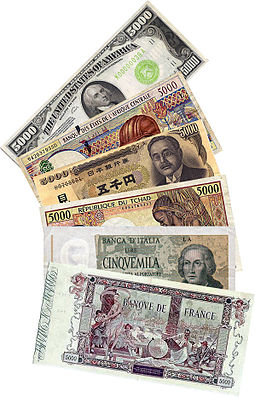The Need of money has become mandatory for everyone . Without money , Life survival becomes difficult as billions of people life totally depend on money . It is very shocking that ' A piece of paper ' - MONEY is controlling the living of Human beings . Every human being is insane over money but other living beings don't . If there is a ' scarcity of money - RECESSION ' than people survival become difficult but other living beings life do not affected .
An education :- A ladder of success
Education is the key requirement of every being . Humans , animals and other beings are needed education for mental growth and development . We cannot buy education through money but we can earn anything through education . Most of the people spend time to gain Money but don't spend time on gaining Education . An education with deep understanding is the source of wisdom otherwise education is the wastage . Real money is the Education but Artificial money is the currency notes . Those who try to get good education always wins .

Money Grubbing
Money grubbing signifies the lust for earning money irrespective of its source hardwired in the mind of many peoples. Demand is directly proportional to greed. Facilitation is the root cause of greed for money. Everyone seeks happiness in money rather than peace. Empowering the need of money can lead to avarice.

Vedas : An ancient sacred Text
Vedas is an old ritual text which is written in an old script " Vedic Sanskrit " . It is a sacred text in hinduism which originated in ancient India . Vedas means Knowledge or wisdom . Vedas are also consider " Shruti " means What is heard . According to orthodox Indian theologian , Vedas was written by ancient sages after extreme meditation .

Acid rain
Acid rain champions
the destruction of environment . It
causes severe respiratory diseases such as Asthma , Bronchitis , pneumonia , lung problems
. When air pollution emits sulphur dioxide & Nitrogen oxide , they amalgamate with
molecules of water that are present in a cloud &
formed acid cloud which falls in the
form of acidic rain . Sulphur dioxide formed during volcanic eruption &
Nitrogen dioxide released during lighting .
Avatar of Vishnu || Supreme God ||
Dashavatara
( Ten
avatars of Vishnu )
Matsya, Kurma, Varaha, Narasimha, Vamana,Parashurama, Rama, Krishna, Buddha and Kalki
Ten Avatars of Lord Vishnu :-
1. Matsya

Matsya (fish) from the Satya Yuga
Vishnu ( God of preservation ) takes the form of a fish to save Manu from the deluge, after which Matsya takes his boat to the new world along with one of every species of plant and animal, gathered in a massive devastation.
MANU || First Human on Earth ||
According to Indian Mythology , Manu is the first man and the legendary author of an
important Sanskrit law code, the Manusmriti (Laws of Manu) .
In Hindu tradition, Manu is the progenitor of humanity, who appears in the world at the start of a new kalpa (aeon), after universal destruction.
Manu is the root-word for both the Sanskrit 'Manushya' and the English 'Man' that derives origin from the Germanic 'Mannus' which stems from the same root as Manu.
The current world is that of Vaivasvata, the
seventh Manu of the aeon of the white boar (sveta varaha kalpa). Vaivasvata,
also known as Sraddhadeva or Satyavrata, was the king of Dravida before
the great flood.
Manu has blood relation with the Indo-European “ man ” and also has an etymological connection with the Sanskrit verb man, “to think” .
Manu appears in the Vedas, the sacred literature of Hinduism, as the performer of the first sacrifice .
Manu is also known as the first king, and most rulers of medieval India traced their genealogy back to him, either through his son (solar line) or his daughter (lunar line).
Manu has blood relation with the Indo-European “ man ” and also has an etymological connection with the Sanskrit verb man, “to think” .
Manu appears in the Vedas, the sacred literature of Hinduism, as the performer of the first sacrifice .
Manu is also known as the first king, and most rulers of medieval India traced their genealogy back to him, either through his son (solar line) or his daughter (lunar line).
In the story of the great flood, Manu
combines the characteristics of the Hebrew Bible figures of Noah,
who preserved life from extinction in a great flood, and Adam, the first
man & the Gilgamesh flood myth
Matsya protecting Vaivasvata Manu and the seven
sages at the time of Deluge
Manu was warned of the flood by the Matsya avatar of Vishnu, and built a boat that carried his family and the seven sages to safety, helped by Matsya. When the flood move away , Manu, the sole human survivor, performed a sacrifice, pouring oblations of butter and sour milk into the waters.After a year there was born from the waters a woman who announced herself as “the daughter of Manu”.
These two then became the ancestors of a new human race to replenish the earth.
In the Mahabharata (“Great Epic of the
Bharata Dynasty”), the fish is identified with the god Brahma, while
in the Puranas (“Ancient Lore”) it is Matsya, the fish
incarnation of Lord Vishnu.
The earliest extant text that mentions this story is the Shatapatha Brahmana (dated variously from 700 BCE to 300 BCE)
In the cosmological speculations of later Hinduism, a day in the life of Brahma is divided into 14 periods called manvantara, each of which lasts for 306,720,000 years.
The lifespan of a Manu is called manvantara.
According to the Bhagavad Gita, the lifespan of one Manu is 71 Mahayugas (306,720,000 years), and each Mahayuga is 4,320,000 years.
The present Manu has already lived for 28 Mahayugas, which is 120,960,000 years.
In every secondary cycle the world is re-created, and a new Manu appears to become the father of the next human race.
The present age is considered the seventh Manu cycle.
The earliest extant text that mentions this story is the Shatapatha Brahmana (dated variously from 700 BCE to 300 BCE)
In the cosmological speculations of later Hinduism, a day in the life of Brahma is divided into 14 periods called manvantara, each of which lasts for 306,720,000 years.
The lifespan of a Manu is called manvantara.
According to the Bhagavad Gita, the lifespan of one Manu is 71 Mahayugas (306,720,000 years), and each Mahayuga is 4,320,000 years.
The present Manu has already lived for 28 Mahayugas, which is 120,960,000 years.
In every secondary cycle the world is re-created, and a new Manu appears to become the father of the next human race.
The present age is considered the seventh Manu cycle.
According to the Puranas, 14 Manus appear in each kalpa. The period of each Manu is called Manvantara. we currently live in the kalpa (aeon) of the white boar (sveta varaha kalpa), a part of the Kali Yuga.
The 14 Manus of the current aeon are :-
1. Svayambhuva
2. Svarocisa
3. Uttama
4. Tamasa

5. Raivata
6. Chakshusha (Cākṣuṣa)
7. Vaivasvata (the current Manu)
8. Savarni
9. Daksa Sarvani
10. Brahma Sarvani
11. Dharma Sarvani
12. Rudra Sarvani
13. Deva Sarvani
14. Indra Sarvani
Bibliography :- Manu ,
#Enigma of Nazca Lines

 The Nazca region lies
between the Pacific coast of Southern Peru and the Andean foothills. The entire
region is made up of strange lines - some in geometric shapes, some in the
shape of animals and birds. The lines and pattern on the desert floor seems to
be the work of a mad geometrician and a giant. This is one of the most baffling
aspect. The archaeology and the archaeologists have no satisfactory answers.
Despite all
The Nazca region lies
between the Pacific coast of Southern Peru and the Andean foothills. The entire
region is made up of strange lines - some in geometric shapes, some in the
shape of animals and birds. The lines and pattern on the desert floor seems to
be the work of a mad geometrician and a giant. This is one of the most baffling
aspect. The archaeology and the archaeologists have no satisfactory answers.
Despite all 
Hindi Numbers || हिंदी संख्या ||
English
|
Hindi
|
Translation
|
|
Zero (00)
|
शून्य (०)
|
śhunya/siphar
|
|
One (1)
|
एक (१)
|
ēk
|
|
Two (2)
|
दो (२)
|
do
|
|
Three (3)
|
तीन (३)
|
teen
|
|
Four (4)
|
चार (४)
|
chaār
|
|
Five (5)
|
पांच (५)
|
pānch
|
|
Six (6)
|
छै (६)
|
che
|
|
Seven (7)
|
सात (७)
|
saāt
|
|
Eight (8)
|
आठ (८)
|
āṭh
|
|
Nine (9)
|
नौ (९)
|
nau
|
|
Ten (10)
|
दस (१०)
|
das
|
|
Eleven (11)
|
ग्यारह (११)
|
gyārah
|
|
Twelve (12)
|
बारह (१२)
|
bārah
|
|
Thirteen (13)
|
तेरह (१३)
|
tērah
|
|
Fourteen (14)
|
चौदह (१४)
|
chaudah
|
|
Fifteen (15)
|
पंद्रह (१५)
|
pandrah
|
|
Sixteen (16)
|
सोलह (१६)
|
solah
|
|
Seventeen (17)
|
सत्रह (१७)
|
satrah
|
|
Eighteen (18)
|
अट्ठारह (१८)
|
aṭṭhārah
|
|
Nineteen (19)
|
उन्नीस (१९)
|
unnis
|
|
Twenty (20)
|
बीस (२०)
|
bees
|
Subscribe to:
Comments (Atom)




